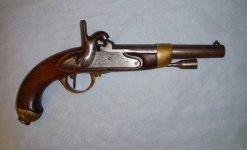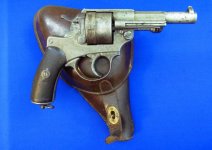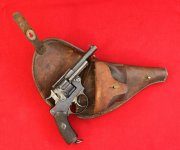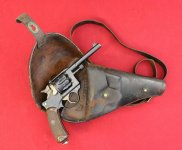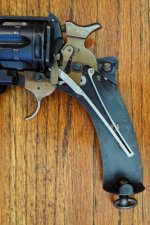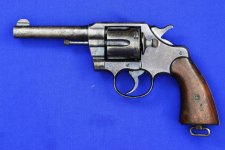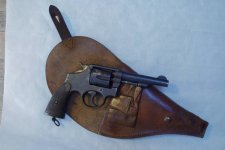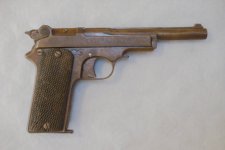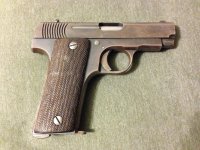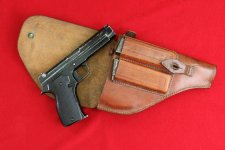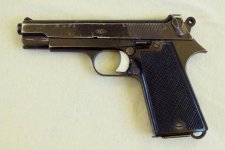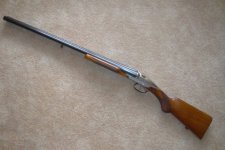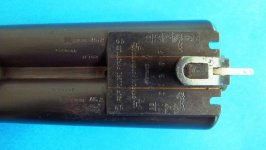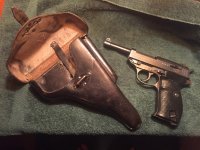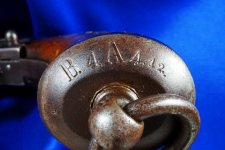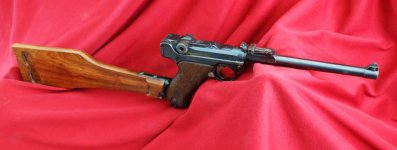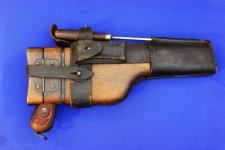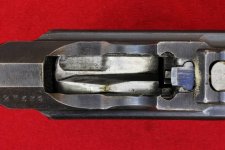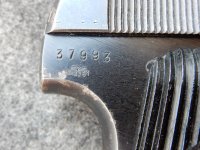French Pistols from two world wars. In the Franco-Prussian war of 1870, France was badly trounced. Their pistol at the time was the Mle (French abbreviation for 'model') 1822 T bis. The French, being on the losing side of the war, got their improved handgun, the Mle 73, out a lot quicker than Germany who waited until 1879 to introduce theirs, and it was somewhat modified in 1883. The Mle 73 was an excellent weapon and was in many respects superior to our own 1873, the SAA; it was double action and the mechanism was very sturdy. The left side plate could be unscrewed for access to the mechnism, if repairs were needed. Its only negative was the rather anemic 11mm cartridge. However it fought in the French conquest of the African and Indchinese colonies against very fierce opposition and its stopping power was never in question. It was used in WW I and a few were used in WW II by the Resistance. By that time ammo was very scarce and some had their chambers hogged out with a file until they would chamber the 45 ACP round. They ussually held together long enough that the user could obtain a better weapon.
For offices there was the Mle 1874, also in 11mm. It had a shorter barrel and fluted cylinder and was blued. The 1873 was left in the white, when black powder fouling was cleaned with water, primers were corrosive and the revolvers were carried in leather holsters cured with tannic acid. 1873s, usually have poor exteriors. The holsters for the Mles 73 and 74 had a pouch for spare ammo, with twelve cartridge loops for two reloads.
The 1873 was becoming increasingly obsolete and in 1892 a new revolver was introduced, in 8mm caliber. It was designed as a cavalry pistol. The cylinder swung out on the right side; for reloading it was held in the left hand along with the reins, while loading was done with the right hand. It had springs to provide friction to prevent the crane from closing and the cylinder from rotating when bouncing around on top of a horse. The holster originally had cartridge loops for spare cartridges like the earlier revolvers but were soon modified to carry three packets of six cartridge, or one reload per package. Many early holsters wre also modifed to carry 8mm packets. The Mle 92 had the same pivoting sideplate as the Mle 73, but the retaining screw was captive. Parts were numbered in the order in which they should be removed. This revolver was produced until the 1920s, and remained the official French handgun until the adoption of the Mle 3A automatic psitol in 1937.
Photos:
Mle 1822 T bis.
Mle 1873 with clamshell holster.
Mle 1874.
Mle 1892.
Mle 1892 lockwork.
For offices there was the Mle 1874, also in 11mm. It had a shorter barrel and fluted cylinder and was blued. The 1873 was left in the white, when black powder fouling was cleaned with water, primers were corrosive and the revolvers were carried in leather holsters cured with tannic acid. 1873s, usually have poor exteriors. The holsters for the Mles 73 and 74 had a pouch for spare ammo, with twelve cartridge loops for two reloads.
The 1873 was becoming increasingly obsolete and in 1892 a new revolver was introduced, in 8mm caliber. It was designed as a cavalry pistol. The cylinder swung out on the right side; for reloading it was held in the left hand along with the reins, while loading was done with the right hand. It had springs to provide friction to prevent the crane from closing and the cylinder from rotating when bouncing around on top of a horse. The holster originally had cartridge loops for spare cartridges like the earlier revolvers but were soon modified to carry three packets of six cartridge, or one reload per package. Many early holsters wre also modifed to carry 8mm packets. The Mle 92 had the same pivoting sideplate as the Mle 73, but the retaining screw was captive. Parts were numbered in the order in which they should be removed. This revolver was produced until the 1920s, and remained the official French handgun until the adoption of the Mle 3A automatic psitol in 1937.
Photos:
Mle 1822 T bis.
Mle 1873 with clamshell holster.
Mle 1874.
Mle 1892.
Mle 1892 lockwork.

